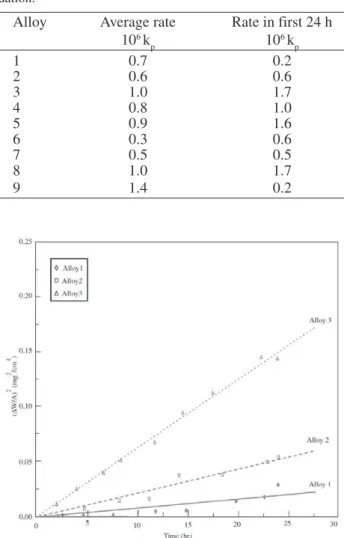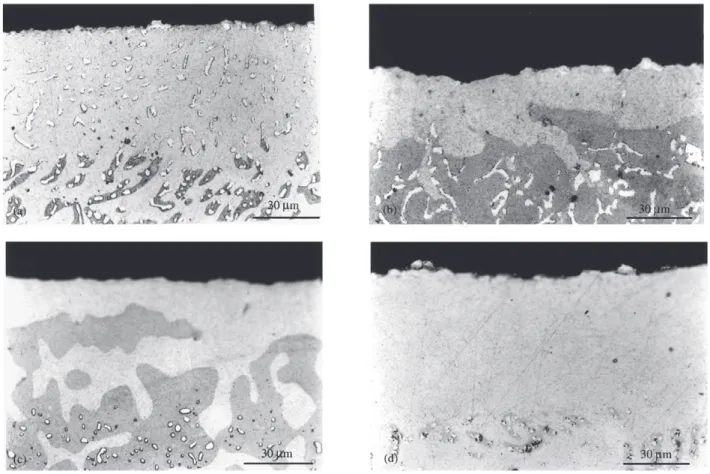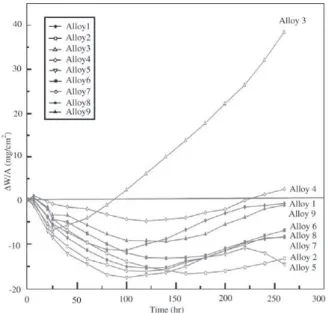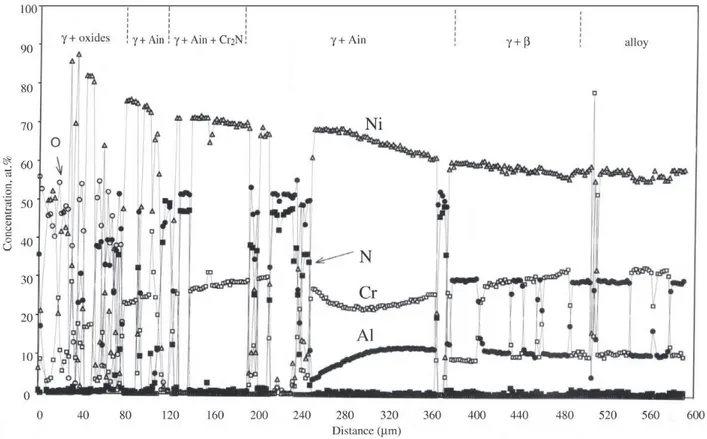*e-mail: msshanhan@hotmail.com, d.young@unsw.edu.au
Presented at the International Symposium on High Temperature Corrosion in Energy Related Systems, Angra dos Reis - RJ, September 2002.
Oxidation – Nitridation of Ni-Cr-Al Alloys
Susan Hana,b*, David John Younga*
aSchool of Materials Science & Engineering, University of New South Wales
Sydney, 2052, Australia
bCurrent address: #701, 816 4th Ave SW, Calgary, AB T2P 2Y1, Canada
Received: September 2, 2002; Revised: September 4, 2002
A series of alloys containing 24-36 wt pct Cr and 13.5 – 25.0 wt pct Al was reacted with air at 1100°C for 260 h. The products of isothermal reaction were scales of α-Al2O3 plus small amounts of Cr2O3. These grew according to parabolic kinetics, interrupted by episodic weight losses caused by partial spallation. No nitridation occurred during the isothermal exposures. Reaction during thermal cycling for up to 260 one hour cycles was much more severe. Repeated scale spallation led to subsurface alloy depletion in aluminium and, to a lesser extent, chromium. This caused transformation of the prior alloy three-phase structures (α-Cr+β-NiAl+γ-Ni) to single-phase γ -nickel solution. Destruction of the external scale allowed gas access to this metal which was able to dissolve both oxygen and nitrogen. Inward diffusion of the two oxidants led to development of a complex internal precipitation zone: Al2O3 and Cr2O3 beneath the surface, then Al2O3 then AIN, then AIN + Cr2N and finally AIN alone in the deepest region. Diffusion-controlled kinetics were in effect initially, but mechanical damage to the internal precipitation zone led to more rapid gas access and approximately linear kinetics in the long term.
Keywords: Thermal cycling, Diffusion, Precipitation, Solubility product, Ni-Cr-Al alloys, Air
1. Introduction
Because nitrogen is present in air and combustion gases, nitridation of alloys is in principal to be expected if their oxide scales are permeable to nitrogen. Chromium oxide
scales are known1,2 to transmit nitrogen, and Cr
2N forms
either as a sub-scale layer or as internal precipitate. This effect can be expected to be more severe under thermal cy-cling conditions which lead to oxide scale damage, reduc-ing its effectiveness as a barrier to nitrogen3,4.
Alumina scales might be expected to provide better pro-tection against nitrogen entry. However, an examination of the behaviour of alumina-forming Ni-Cr-Al alloys under
thermal cycling conditions5 has shown that a complex
pat-tern of inpat-ternal oxidation and nitridation is developed. Alumina forming nickel based materials are of interest as corrosion resistant coatings for superalloy components. The present work was concerned with comparing the
be-haviour of three-phase (α-Cr+β-NiAl+ γ -Ni) alloys under
isothermal and temperature cycling conditions.
2. Experimental methods
Nine ternary alloys were argon-arc melted and then
an-nealed under flowing argon for 24 h at 1100°C. Alloy
com-positions measured by electron probe micro-analysis (EPMA) and constituent phase volume fractions measured by automated image analysis, using an optical microscope, are listed in Table 1. The latter were in good agreement with equilibrium values calculated from the phase diagram and constituent phase densities.
Individual oxidation samples were cut from the alloys, their surfaces ground to a 1200 grit finish and ultrasoni-cally cleaned in acetone immediately before use. The sam-ples were then subjected to temperature cycling oxidation
at 1100°C in still laboratory air. Each cycle consisted of
Reaction products were characterised using standard metallographic techniques, including the measurement of internal precipitation depths.
3. Results
Isothermal weight gain kinetics were approximately parabolic, interrupted by episodic weight losses as exem-plified by the data in Fig. 1. The early stage of reaction, before any obvious weight loss occurred, was also approxi-mately parabolic (Fig. 2). The data were regressed on the Eq. (1):
(∆W/A)2 = k
p t + C (1)
where ∆W/A denotes weight change per unit area arrived at
in time t, and kp and C are constants. Two values of the rate
constant, kp, were arrived at : an average for the full data set over 260 h and an estimate for the first 24 h, in each case ignoring discontinuities in the weight uptake curves. The results are summarised in Table 2.
After cooling from reaction temperatures, alloys 1,5 and 7 retained their scales apparently intact, but the others sus-tained substantial degrees of scale loss. In situ analysis by X-ray diffraction (XRD) of the oxidised surfaces produced characteristic patterns for α-Al2O3, γ-Ni and α-Cr for all
alloys. In addition, a small amount of Cr2O3 (distinguished
from Al2O3 by d-spacing values) was detected on every
al-loy except 5 and 7. No NiO or NiCr2O4 was ever detected.
Examination of metallographic sections after 260 h of isothermal oxidation yielded the results shown in Fig. 3. The fragile oxide scales could not be preserved
Figure 1. Weight uptake kinetics during isothermal oxidation. Figure 2. Parabolic plots of early stage oxidation.
Table 1. Alloy compositions (at. pct.) and phase constitutions
(volume fraction).
Alloy Cr Al α-Cr β-NiAl γ-Ni
1 31.0 20.7 0.18 0.56 0.27
2 36.4 14.1 0.11 0.30 0.59
3 24.8 24.6 0.15 0.72 0.13
4 37.6 19.0 0.30 0.53 0.17
5 24.2 21.7 0.09 0.53 0.38
6 35.6 18.0 0.26 0.40 0.34
7 24.3 22.3 0.09 0.60 0.32
8 31.3 14.7 0.07 0.34 0.59
9 29.5 24.0 0.21 0.71 0.08
Table 2. Parabolic rate constant (mg2/cm4S-1) for isothermal
oxi-dation.
Alloy Average rate Rate in first 24 h
106 k
p 10
6 k p
1 0.7 0.2
2 0.6 0.6
3 1.0 1.7
4 0.8 1.0
5 0.9 1.6
6 0.3 0.6
7 0.5 0.5
8 1.0 1.7
through the mounting procedure, and were never visible metallographically. No internal oxidation products were found in any alloy, but all had undergone subsurface phase transformations. The four patterns of alloy phase transfor-mation found are shown in Fig. 3. The phases present were
identified by EPMA: the bright white phase is α-Cr, the
mid grey phase β-NiAl and the light grey one γ-Ni. Alloys
1, 2, 4, 6 and 9 developed a single subsurface zone of α + γ
(Fig. 3a); Alloy 3 developed successive zones of α + γ, then
γ and then γ + β (Fig. 3b); Alloys 5 and 7 developed two
zones, γ at the surface, and γ + β beneath (Fig. 3c); Alloy 8
developed a single γ-phase layer, but with particles of α-Cr
visible at the external surface (Fig. 3d).
Weight change kinetics during cyclic oxidation are shown in Fig. 4. All alloys experienced initial weight losses. The rate of weight loss slowed with time until a period of net weight increase followed. Alloy 3 soon commenced to gain weight, and continued to do so at a rapid, linear rate. The other alloys gained weight much more slowly.
Thermally cycled alloy surfaces suffered extensive scale spallation. Analysis by XRD of the surfaces after reaction
showed γ-Ni to be the major phase, with smaller amounts
of Al2O3, Cr2O3, NiCr2O4 and, in the case of Alloy 7, NiO. Metallographic cross-sections revealed large quantities of internal corrosion products, and a typical example is shown in Fig. 5. Microprobe analysis identified the precipitates. The large, irregular precipitates beneath the alloy surface
were Cr2O3 and Al2O3, the faceted and needle-shaped
pre-cipitates in the wide, inner zone were AlN and the light
coloured particles were Cr2N. A typical analysis is shown
i n
Fig. 6. It is seen that the metal matrix containing the
pre-cipitates is γ-nickel. This was the case for all alloys, and
transformation fronts were clearly visible at or ahead of the internal nitride precipitation front.
4. Discussion
4.1. Isothermal Reaction
Under isothermal conditions, all alloys formed external scales, the remnants of which after spallation were
pally Al2O3. No internal attack was observed and no nitro-gen penetrated the scales to react with the underlying al-loys. Clearly the scales remained protective, despite the rela-tively frequent occasions of scale damage - visible in the weight uptake kinetics - occurring during reaction. It is con-cluded that these instances of scale damage were quickly repaired by scale regrowth.
Average parabolic scaling rates varied within a narrow range: 3 × 10-7 to 1.4 × 10-6 mg2/cm4 s. The observation of parabolic kinetics indicates diffusion control and implies that the kinetic regime observed corresponded to steady-state scale growth. It is concluded from this, and from the fact that NiO
and NiCr2O4 were never observed, that the initial transient
oxidation stage6,7 had passed. The magnitude of the k
p values observed was similar to those measured at 1100 °C for alumina-forming (α + β) alloys8, β-NiAl and β-Ni(Cr)Al al-loys7,9,10 and some γ-Ni-Cr-Al alloys6. Conversely, the
pres-ently observed rates were slower than those observed9,11 for
chromia-formers, 10-5 to 10-4 mg2/cm4s at 1100°C. It is therefore concluded that the protective scale developed during isother-mal oxidation was principally alumina.
Selective oxidation of aluminium led to depletion of the metal from the alloy subsurface regions. This depletion caused phase transformations in the alloy. As seen from the schematic diffusion path in Fig. 7, the selective removal of aluminium from the three-phase alloys investigated here
must lead eventually to single γ-phase formation. Evidently,
the phase assemblages seen in Fig. 3 represent partial trans-formation in some cases.
In all alloys, the aluminium-rich β-NiAl phase had
dis-solved beneath the surface in response to the depletion
proc-Figure 4. Weight change kinetics during cyclic oxidation5.
Figure 5. Cross-section of Alloy 1 after 260 cycles of reaction.
ess. As expected, the dissolution depths were greater in
al-loys of lower β-phase volume fraction. Whilst dissolution of
the β-phase was rapid, that of α-Cr was less so. The alloys
with initial high α volume fractions (1, 2, 4, 6 and 9) still
contained substantial amounts of the chromium-rich phase after 260 h of isothermal reaction. This reflected the differ-ing drivdiffer-ing forces for aluminium and chromium dissolution. The former was the large gradient in aluminium activity de-veloped by the selective oxidation process. The latter, how-ever, was the smaller, local gradient in chromium activity
re-sulting from the increased solubility for chromium in γ-Ni
developed as the aluminium concentration decreased. The appearance of significant quantities of the
α-chromium phase at the reacted alloy surface is not
pre-dicted from the above model. As seen in Fig. 3b, the α-phase
had disappeared throughout most of the depletion zone but was still present at the alloy-scale interface, where
chro-mium solubility in γ-Ni is expected to be highest and
expo-sure to the dissolution process had occurred for the longest time. An alternative possibility is that the surface chromium had accumulated as a result of reduction by outwardly
dif-fusing aluminium of early-stage transient Cr2O3.
4.2. Cyclic Oxidation
Evi-dently the scale damage occurring during isothermal oxi-dation became acute under the increased stresses resulting from thermal cycling. At longer times, as the rate of scaling decreased, the internal precipitation reactions produced weight increases. These balanced the weight loss caused by spallation, and eventually became the major process, lead-ing to net weight increases for all alloys.
External scale constitutions reflected the selective oxi-dation of aluminium and chromium, and ultimately the de-velopment of nickel-containing oxide when scale rehealing
capability was lost. The more stable Al2O3 was the early
stage oxide scale as seen in the isothermal experiment. The repeated loss of this scale would have reduced the residual alloy aluminium concentration to the level where exclusive
Al2O3 formation became impossible and chromium-rich
oxides also formed. Further subsequent scale loss would then have reduced the chromium content also, eventually allowing the formation of NiO and spinel.
The very large extent of scale spallation is in agreement with earlier results on two-phase (α + β) alloys12,13 and
sin-gle phase β-NiAl14. It is known that the presence of a
sepa-rate alloy α-chromium phase with its very different
coeffi-Figure 6. Microprobe analysis within subsurface zone of Alloy 5 after 260 cycles of reaction.
Figure 7. Isothermal section of Ni-Cr-Al12, showing schematic
dif-fusion path for aluminium depletion.
cient of thermal expansion15 can promote spallation during
temperature cycling.
micro-structure into a single γ-phase in which the precipitates were embedded. The distribution of the internal precipitation products reflected their relative stability and the higher
per-meability of nitrogen16. Details of the precipitate
distribu-tions and the diffusion controlled growth of the precipitate
zone are described elsewhere5. The general pattern was
para-bolic kinetics in the early stages of reaction followed by linear kinetics at long term. Alloy 3, however, displayed linear kinetics throughout the reaction.
The magnitude of the parabolic rate constant for
inter-nal precipitation has been shown5 to be consistent with
con-trol by inward diffusion of nitrogen. The long term linear kinetics which occurred at rates faster than could be sus-tained by metal matrix diffusion of nitrogen were attributed to gas phase transport occurring through parts of the reac-tion zone. This was a consequence of mechanical damage to the zone caused by stresses generated during thermal cycling, as a result of differences in thermal expansion co-efficients between metal and precipitates.
Internal precipitation occurred within a matrix of single
phase γ-nickel. As discussed earlier, selective oxidation of
aluminium from these three-phase alloys must lead
eventu-ally to γ-phase formation. Because of the high permeability
of nickel for both oxygen and nitrogen17-20 internal
precipi-tation within this alloy sub layer was rapid, particularly in the case of nitridation.
5. Conclusions
Isothermal air oxidation of the γ + α + β alloys at 1100 °C
produced scales of protective, self-healing α-Al2O3. These
scales grew according to parabolic kinetics, at rates typical of alumina formers.
Partial scale loss occurred during the course of isother-mal reaction. However, in view of the magnitude of the over-all rate constants and the fact that scales remained protec-tive, it is concluded that scale damage was quickly repaired by scale regrowth.
Isothermally grown scales were protective and prevented nitrogen from reaching the underlying alloys.
Selective oxidation of aluminium and its depletion from the alloy subsurface region promoted phase transformations which were incomplete in the time scale of these experi-ments.
Cyclic air oxidation at 1100 °C produced much more damage. Repeated scale spallation led to initial weight losses, but subsequent extensive internal precipitation led to net mass gain. Sub-surface alloy depletion in aluminium and chromium caused transformation of the alloy
micro-structure to single phase γ-nickel.
The high permeability of γ-nickel for oxygen and
nitro-gen permitted rapid internal precipitate zone formation. The controlling process was initially diffusion of dissolved ni-trogen through the nickel, but in the long term faster
reac-tion rates reflected a contribureac-tion from gas phase mass trans-port in a mechanically disrupted alloy surface zone.
Acknowledgements
This work was supported by a grant from the Australian Research Council. S. Han gratefully acknowledges the re-ceipt of an Australian Development Scheme Scholarship during the tenure of which this was carried out.
References
1. Snavely, C.A.; Faust, C.L. J. Electrochem. Soc., v. 97,
n. 99, 1950.
2. Zheng, X.G.; Young, D.J. Mater. Sci. Forum, v. 251-254,
567, 1997.
3. Lai, G.Y. Proc. ASM 1993 Metals Congress – Materials
Week 93, Advanced Materials and Coatings for Com-bustion Turbines, (Eds. V.P. Swaminathan and N.S. Cheruva, Pittsburgh, PA, 1993).
4. Chang, S.Y.; Krupp, U.; Christ, H.-J. in Cyclic Oxidation
of High Temperature Materials, (Eds. M. Schutze and W.J. Quadakkers, p63 IOM Communications Ltd, Lon-don, 1999).
5. Han, S.; Young, D.J. Oxid. Met., v. 55, n. 225, 2001.
6. Giggins, C.S.; Pettit, F.S. J. Electrochem. Soc., v. 118,
n. 1782, 1971.
7. Brum, M.W.; Grabke, H.J. Corros. Sci., v. 33, n. 1677,
1992.
8. Cheung, W.H. PhD Thesis, University of New South Wales, 1994.
9. Smialek, J.L.; Meier, G.H. Chapter 11 in Superalloys II Ed. C.T. Sims.
10. Doychak, J.; Smialek, J.L.; Barrett, C.A. in Oxidation
of High Temperature Intermetallics, (Eds T. Grabstein and J. Doychak, TMS, Warrendale, PA, 1989).
11. Giggins, C.S.; Pettit, F.S. Trans. AIME, v. 245, n. 2495
1969.
12. Gleeson, B.; Cheung, W.; Young, D.J. Corrosion Sci.,
v. 35, n. 6923, 1993.
13. Prajitno, D.; Gleeson, B.; Young, D.J. Corrosion Sci.,
v. 39, n. 639, 1997.
14. Smeggil, J.G. Surf. Coat. Technol., v. 46, n. 143, 1991.
15. Lowell, C.E.; Garlick, R.G.; Henry, B. Met. Trans. A,
v. 7A, n. 655, 1976.
16. Meijering, J.L. in Advances in Materials Research, 5th
ed, (Ed, H. Herman, Wiley-Interscience, New York, 1971). 17. Park, J.-W.; Altstetter, C.J. Met. Trans. A, v. 18A, n. 43,
1987.
18. Savva, G.C.; Weatherly, G.C.; Kirkaldy, J.S. Met. Trans.
A, v. 27A, n. 1611, 1996.
19. Krupp, U.; Christ, H.-J. Oxid. Met., v. 52, n. 227, 1999.
20. Udyavar, M.; Young, D.J. Corrosion Sci., v. 42, n. 861,



